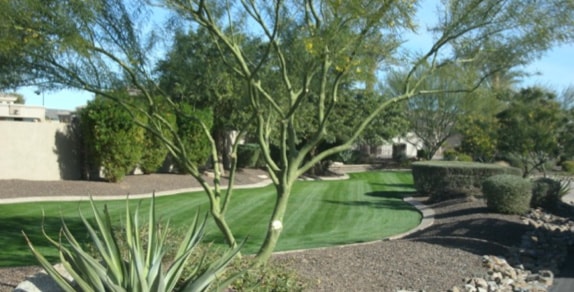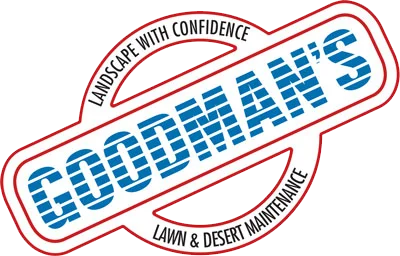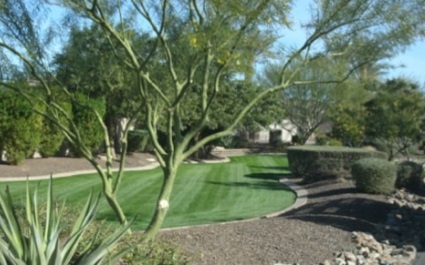
Arizona residents are lucky, unlike other parts of the country, you have a choice whether to keep your lawn green all year, or to let it go dormant. Most people do chose to keep it green. In addition to being more esthetically pleasing than a straw colored lawn, maintaining a healthy green lawn all year provides the added benefit of keeping weeds from getting a foothold in your lawn.
It is important that you make the decision early on, so you can properly prepare your lawn for overseeding. At Goodman’s, we start the discussion with our customers in August, so that we can begin transitioning their lawns in September for installation in October. Waiting until your Bermuda lawn goes dormant naturally before overseeding is not a good idea. Good seed germination takes sun (warmth), adequate water and contact with soil. You want to make sure temperatures are still warm enough to help with germination. There is only a small window of opportunity each year when conditions are ideal, which is why it is so important to plan ahead. Late season installations should be avoided.
Winter Lawn Overseeding
Warm season grasses like Bermuda go dormant and turn blondish/brown when soil temperatures fall below 60 degrees farenheit. If you want your lawn to remain green you must overseed the Bermuda with our cooler season grass, Rye. Perennial Ryegrass is preferred to annual Ryegrass for winter because it’s blade is darker green, hardier, finer and easier to mow.
Do not overseed a Bermuda lawn unless it has been established for at least three months. Overseeding is also not recommended for St. Augustine lawns. If you have Zoysia, use half the recommended seeding rate. For shaded lawn areas overseeding with Fescue is recommended.
How To Install A Winter Lawn in Phoenix, Arizona
- Stop fertilizing 4 to 6 weeks prior to overseeding your Bermuda lawn, and cut back on watering.
- If needed, dethatch lawn lightly. Thatch is dead grass below the green part of the lawn and above the soil. Set the dethatcher blades to run at about 1/4” above the soil. DO NOT dig into the soil, you may damage the root structure of your Bermuda, and you DO want it to fill back in next year when the Rye dies. Remember to run the dethatcher in two directions.
- Rake the removed thatch into piles and dispose of it.
- The next step is scalping. This lowers the height of the Bermuda, making it easier for the Rye see to receive the sunlight/warmth it needs to germinate. If you are using a reel mower scalp to 1/4” to 1/2”. With a rotary mower 3/4” is acceptable.
- Apply 10 to 15 lbs of seed per 1000 sq. ft. of lawn. Include a starter fertilizer with seed.
- Rake or drag to ensure seed makes contact with soil.
- Lightly cover seed with no more than 1/4” of weed and salt free organic mulch. Keep seeds damp by watering 3 to 4 times per day with light 5 to 7 minute durations. You want to avoid seed becoming dry, or overly saturated.
- After germination (7-10 days), reduce watering frequency as needed. This is dependent upon the type of sprinkler heads you have, temperature, wind, and rain, and may vary from once every two weeks to every other day. Only water enough to avoid wilt between watering.
- When grass is 2” tall (about 2 weeks) mow for the first time. Do not remove more than 1/3 of the blade at each mowing and make sure your mower blades have been recently sharpened. Allow germinated grass to establish deeper roots before mowing on a lower setting.
- Two weeks after planting, fertilize your lawn using a balance fertilizer. Fertilize monthly, or as needed after that.
- Apply iron & calcium nitrate at least once before frost.
Call Goodman’s
Keep your lawn looking beautiful year around. Let Goodman’s Landscape Maintenance provide you with a quote on installing winter lawn in your front or backyard. Give us a call today at 602-861-1144 for a friendly estimate today.



